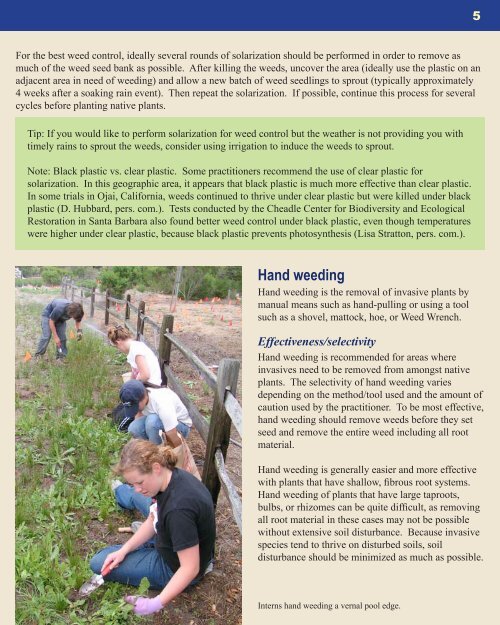Guide to Native and Invasive Plants Storke Ranch Vernal ... - Cram
Guide to Native and Invasive Plants Storke Ranch Vernal ... - Cram
Guide to Native and Invasive Plants Storke Ranch Vernal ... - Cram
You also want an ePaper? Increase the reach of your titles
YUMPU automatically turns print PDFs into web optimized ePapers that Google loves.
For the best weed control, ideally several rounds of solarization should be performed in order <strong>to</strong> remove as<br />
much of the weed seed bank as possible. After killing the weeds, uncover the area (ideally use the plastic on an<br />
adjacent area in need of weeding) <strong>and</strong> allow a new batch of weed seedlings <strong>to</strong> sprout (typically approximately<br />
4 weeks after a soaking rain event). Then repeat the solarization. If possible, continue this process for several<br />
cycles before planting native plants.<br />
Tip: If you would like <strong>to</strong> perform solarization for weed control but the weather is not providing you with<br />
timely rains <strong>to</strong> sprout the weeds, consider using irrigation <strong>to</strong> induce the weeds <strong>to</strong> sprout.<br />
Note: Black plastic vs. clear plastic. Some practitioners recommend the use of clear plastic for<br />
solarization. In this geographic area, it appears that black plastic is much more effective than clear plastic.<br />
In some trials in Ojai, California, weeds continued <strong>to</strong> thrive under clear plastic but were killed under black<br />
plastic (D. Hubbard, pers. com.). Tests conducted by the Cheadle Center for Biodiversity <strong>and</strong> Ecological<br />
Res<strong>to</strong>ration in Santa Barbara also found better weed control under black plastic, even though temperatures<br />
were higher under clear plastic, because black plastic prevents pho<strong>to</strong>synthesis (Lisa Strat<strong>to</strong>n, pers. com.).<br />
H<strong>and</strong> weeding<br />
H<strong>and</strong> weeding is the removal of invasive plants by<br />
manual means such as h<strong>and</strong>-pulling or using a <strong>to</strong>ol<br />
such as a shovel, mat<strong>to</strong>ck, hoe, or Weed Wrench.<br />
Effectiveness/selectivity<br />
H<strong>and</strong> weeding is recommended for areas where<br />
invasives need <strong>to</strong> be removed from amongst native<br />
plants. The selectivity of h<strong>and</strong> weeding varies<br />
depending on the method/<strong>to</strong>ol used <strong>and</strong> the amount of<br />
caution used by the practitioner. To be most effective,<br />
h<strong>and</strong> weeding should remove weeds before they set<br />
seed <strong>and</strong> remove the entire weed including all root<br />
material.<br />
H<strong>and</strong> weeding is generally easier <strong>and</strong> more effective<br />
with plants that have shallow, fibrous root systems.<br />
H<strong>and</strong> weeding of plants that have large taproots,<br />
bulbs, or rhizomes can be quite difficult, as removing<br />
all root material in these cases may not be possible<br />
without extensive soil disturbance. Because invasive<br />
species tend <strong>to</strong> thrive on disturbed soils, soil<br />
disturbance should be minimized as much as possible.<br />
Interns h<strong>and</strong> weeding a vernal pool edge.















